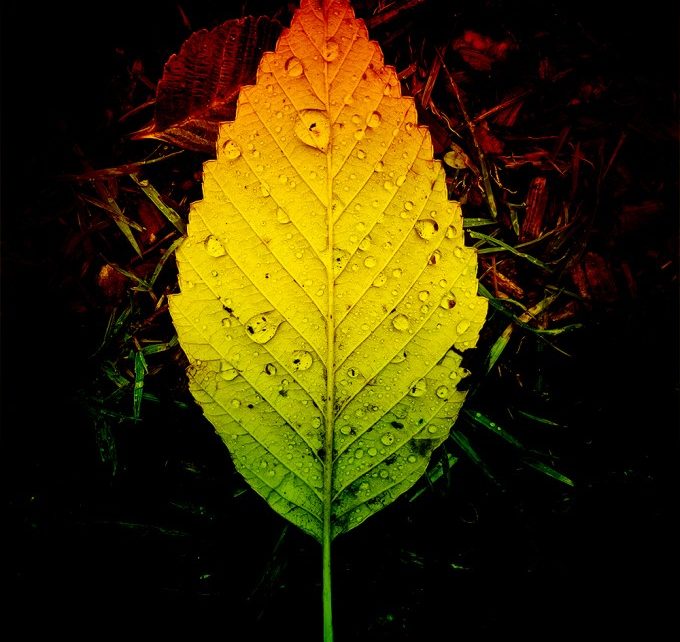“We reach forth and strain every nerve, but we seize only a bit of the curtain that hides the infinite from us.”
Autumn is the season of ambivalence and reconciliation, soft-carpeted training ground for the dissolution that awaits us all, low-lit chamber for hearing more intimately the syncopation of grief and gladness that scores our improbable and finite lives — each yellow burst in the canopy a reminder that everything beautiful is perishable, each falling leaf at once a requiem for our own mortality and a rhapsody for the unbidden gift of having lived at all. That dual awareness, after all, betokens the luckiness of death.
Life and Loss Are One by Maria Popova. (Available as a print and as stationery cards, benefitting The Nature Conservancy.)
But autumn is also the season of revelation, for the seeming loss unveils a larger reality: Chlorophyll is a life-force but it is also a cloak, and when trees shed it from their leaves, nature’s true colors are revealed.
Photosynthesis is nature’s way of making life from light. Chlorophyll allows a tree to capture photons, extracting a portion of their energy to make the sugars that make it a tree — the raw material for leaves and bark and roots and branches — then releasing the photons at lower wavelengths back into the atmosphere. A tree is a light-catcher that grows life from air.
Although the human mind has puzzled over why leaves fall and change color at least as far back as Aristotle, chlorophyll — which shares chemical kinship with the hemoglobin in our blood — was only discovered and named in 1817, by the French pharmacist-chemist duo Joseph Bienaimé Caventou and Pierre Joseph Pelletier. In a lovely touch of humility that distinguishes, always, the scientist from the explorer — the explorer, so eager to name the lands and landmarks he has “discovered” after himself — they wrote in their landmark paper:
We have no right to name a substance long-known, and to the story of which we have added only a few facts; however, we will propose, without granting it any importance, the name chlorophyll, from chloros, color, and φυλλον, leaf: a name that would indicate the role it plays in nature.
Oak by the self-taught 19th-century naturalist, painter, and poet Rebecca Hey from The Spirit of the Woods — the world’s first illustrated encyclopedia of wild trees. (Available as a print.)
But chlorophyll, which is yet to be fully understood, is not the only pigment in trees. Throughout a leaf’s life, four primary pigments course through its cells: the green of chlorophyll, but also the yellow of xanthophyll, the orange of carotenoids, and the reds and purples of anthocyanins. In spring and summer, when the day grow long and bright, chlorophyll saturates leaves as the tree busies itself converting photons into the sweetness of new growth. As daylight begins fading in autumn and the air cools, deciduous trees prepare for wintering and stop making food — an energy expenditure too metabolically expensive in the dearth of sunlight. Enzymes begin breaking down the decommissioned chlorophyll, allowing the other pigments that had been there invisibly all along to come aflame. And because we humans so readily see in trees metaphors for our emotional lives, how can this not be a living reminder that every loss reveals what we are made of — an affirmation of the value of a breakdown?
A similar process take place as fruit ripen from green to varying shades of red, purple, orange, or yellow. Two centuries after the discovery of chlorophyll, a new generation of scientists armed with a new arsenal of tools unimaginable in 1817, in that abiding way science has of only revealing new layers of reality when it lets go of its assumptions, placed bananas in various stages of ripeness under UV light and discovered that as the world’s favorite yellow fruit ripens and its chlorophyll breaks down, it not only reveals the xanthophyll of yellow, but produces the chlorophyll catabolite hmFCC — a previously unknown blue fluorescent compound.
Artwork based on laboratory imaging from Agewandte Chemie: A Journal of the German Chemical Society, international edition, 2008.
Subsequent research has found signs of this blue pigment in devil’s ivy — the evergreen golden pothos thriving in the corner of my library in Brooklyn at this very moment — rendering the mystery of chlorophyll ongoing and filling the human heart with exhilaration. How thrilling to think that something we discovered two centuries ago, something nature created more than one thousand million years ago when the first green plants evolved from prokaryotes, can still shimmer with mystery — a molecular microcosm of the ultimate thrill: the knowledge that however much we might uncover, nature will never cease to be filled with surprise ripe for the reaping. And how humbling to think that we too are animals doing their best to make sense of the world with their creaturely limitations — animals whose vision evolved to peak in so narrow a band of the spectrum, in the tiny wavelength range between red and violet, blind to everything between radio and cosmic rays, blind to ultraviolet light. But if we were butterflies or reindeer, bees or sockeye salmon, bananas might be blue.
“Spectra of various light sources, solar, stellar, metallic, gaseous, electric” from Les phénomènes de la physique by Amédée Guillemin, 1882. (Available as a print and as a face mask.)
The poetic astronomer Maria Mitchell captured this best in her rueful and rapturous observation that “we have a hunger of the mind which asks for knowledge of all around us, and the more we gain, the more is our desire,” and yet “we reach forth and strain every nerve, but we seize only a bit of the curtain that hides the infinite from us.”
Complement with the late, great nature writer Ellen Meloy on the conscience of color from chemistry to culture, then revisit this fascinating read on Turing, trees, and the science of how alive you really are.
donating = loving
For a decade and half, I have been spending hundreds of hours and thousands of dollars each month composing The Marginalian (which bore the unbearable name Brain Pickings for its first fifteen years). It has remained free and ad-free and alive thanks to patronage from readers. I have no staff, no interns, no assistant — a thoroughly one-woman labor of love that is also my life and my livelihood. If this labor makes your own life more livable in any way, please consider lending a helping hand with a donation. Your support makes all the difference.
newsletter
The Marginalian has a free weekly newsletter. It comes out on Sundays and offers the week’s most inspiring reading. Here’s what to expect. Like? Sign up.





